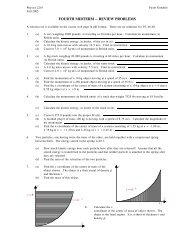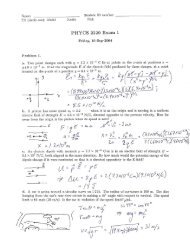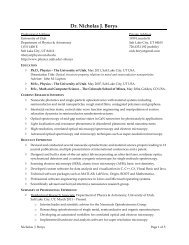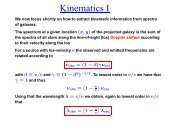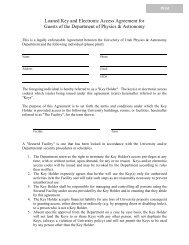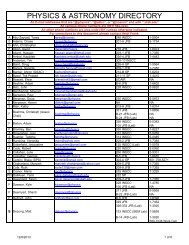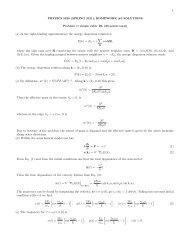Myths and Mysteries of Galaxy Alignment
Myths and Mysteries of Galaxy Alignment
Myths and Mysteries of Galaxy Alignment
Create successful ePaper yourself
Turn your PDF publications into a flip-book with our unique Google optimized e-Paper software.
<strong>Galaxy</strong> <strong>Alignment</strong><br />
Misleading <strong>Myths</strong>, Miserable Mistakes & Mirky <strong>Mysteries</strong><br />
Frank C. van den Bosch (MPIA)
Two Types <strong>of</strong> <strong>Alignment</strong><br />
<strong>Alignment</strong> between orientations <strong>of</strong> neighbouring galaxies<br />
• Important for weak lensing studies<br />
• Of interest for galaxy formation<br />
• Not the topic <strong>of</strong> this talk<br />
<strong>Alignment</strong> between orientation <strong>of</strong> ‘central’ galaxy <strong>and</strong> distribution <strong>of</strong> ‘satellites’<br />
• Potentially important for galaxy-galaxy lensing<br />
• Of interest for galaxy formation<br />
• The topic <strong>of</strong> this talk<br />
• Rich history; full <strong>of</strong> <strong>Myths</strong>, Mistakes & <strong>Mysteries</strong>
The Holmberg Effect<br />
(Holmberg 1969).<br />
Holmberg Effect: Satellite galaxies are preferentially located along the minor<br />
axis <strong>of</strong> disk galaxies<br />
NOTE: Holmberg’s analysis restricted to projected distances r p<br />
<<br />
∼ 50 kpc<br />
Subsequent studies by Hawley & Peebles (1975), Sharp, Lin & White (1979)<br />
<strong>and</strong> MacGillivray et al. (1982) were unable to confirm Holmberg effect.
More History...<br />
Zaritsky et al. (1997): study <strong>of</strong> spatial, projected distribution <strong>of</strong> 72 satellites<br />
around 48 isolated disk galaxies:<br />
• Significant detection <strong>of</strong> Holmberg effect for 300 kpc < r p < 500 kpc.<br />
• No significant alignment detected for r p<br />
<<br />
∼ 50 kpc...
<strong>Alignment</strong> in 2dFGRS<br />
Sales & Lambas (2005): alignment between isolated galaxies (all types) <strong>and</strong><br />
satellites (r p < 500 kpc) in 2dFGRS.<br />
00 11<br />
0000 1111<br />
0000 1111<br />
0000 1111<br />
0000 1111<br />
0000 1111<br />
0000 1111<br />
0000 1111<br />
0000 1111<br />
0000 1111<br />
0000 1111 φ<br />
0000 1111<br />
00000000<br />
00000000<br />
11111111<br />
11111111<br />
00000000<br />
11111111<br />
• Total Sample: ∼ 1500 primaries <strong>and</strong> ∼ 3000 satellites<br />
• Strong, highly significant detection <strong>of</strong> Holmberg effect, but only for<br />
satellites with |∆V | < 160 km s −1 ...<br />
• <strong>Alignment</strong> strength largest for red primaries <strong>and</strong> red satellites
<strong>Alignment</strong> in SDSS<br />
Brainerd (2005): similar primary-satellite selection criteria as Sales & Lambas<br />
but applied to SDSS.<br />
Total Sample: ∼ 2000 primaries <strong>and</strong> ∼ 3300 satellites.<br />
<strong>Alignment</strong> along MAJOR AXIS: Inverse <strong>of</strong> Holmberg Effect
Holmberg <strong>and</strong> the MW...<br />
Even our own Milky Way reveals a Holmberg Effect...<br />
(Kroupa, Theis & Boily 2005).<br />
Distribution <strong>of</strong> the innermost eleven MW satellites with respect to the<br />
orientation <strong>of</strong> the MW disk (blue line)
<strong>Alignment</strong> in SDSS Groups I<br />
We study alignment <strong>of</strong> satellites with orientation <strong>of</strong> central galaxy using<br />
SDSS galaxy groups<br />
<strong>Galaxy</strong> groups obtained with new, halo-based group finder <strong>of</strong> Yang, Mo, vdB<br />
& Jing (2005), applied to NYU-VAGC <strong>of</strong> DR2<br />
Total <strong>of</strong> 53,229 groups with 39,086 unique central-satellite pairs; order <strong>of</strong><br />
magnitude more than any previous study<br />
We study alignment within groups; we only probe only out to R vir<br />
Count N(θ) from groups, <strong>and</strong> from 100 realizations in which orientation <strong>of</strong><br />
centrals is r<strong>and</strong>omized. Compute f pairs (θ) = N(θ)/〈N R (θ)〉<br />
To access significance we compare f pairs (θ) to σ R (θ)/〈N R (θ)〉, <strong>and</strong> we<br />
also compute 〈θ〉 <strong>and</strong> σ θ
<strong>Alignment</strong> in SDSS Groups II<br />
(Yang, vdB, et al. 2006).<br />
• Very significant major axis alignment detected; again opposite to<br />
Holmberg effect, but in agreement with Brainerd (2005)<br />
• <strong>Alignment</strong> stronger around less elongated primaries<br />
• Weak trend that alignment is stronger for fainter satellites
Colour Dependence<br />
(Yang, vdB, et al. 2006).<br />
• Blue primaries show no alignment with either red or blue satellites.<br />
• Red primaries reveal strong alignment with blue satellites <strong>and</strong> even<br />
more so with red satellites.<br />
• Color-trends as in Sales & Lambas (2005), but along major axis....
Halo Mass Dependence<br />
(Yang, vdB, et al. 2006).<br />
<strong>Alignment</strong> stronger in more massive haloes.
Radial Dependence<br />
(Yang, vdB, et al. 2006).<br />
<strong>Alignment</strong> is stronger at smaller halo-centric radii.
Overview<br />
WHO OR WHAT<br />
Holmberg (1969)<br />
Zaritsky et al. (1997)<br />
Zaritsky et al. (1997)<br />
Sales & Lambas (2005)<br />
Brainerd (2005)<br />
Milky Way<br />
Yang et al. (2006)<br />
Yang et al. (2006)<br />
Yang et al. (2006)<br />
Yang et al. (2006)<br />
RESULT<br />
Minor axis alignment for r p < 50 kpc<br />
Minor axis alignment for 300 kpc < r p < 500 kpc<br />
No alignment for r p < 50 kpc<br />
Minor axis alignment in 2dFGRS for r p < 500 kpc<br />
Major axis alignment in SDSS for r < p ∼ 300 kpc<br />
Planar, minor axis alignment <strong>of</strong> eleven satellites<br />
Major axis alignment in SDSS for r p<br />
<<br />
∼ r vir for red centrals<br />
No alignment for blue centrals<br />
<strong>Alignment</strong> stronger in more massive haloes<br />
<strong>Alignment</strong> stronger at smaller halo-centric radii<br />
Who or What is going Wrong <strong>and</strong> Why?
How Observers confuse Theorists<br />
In the 2dFGRS the major axes <strong>of</strong> the galaxies are defined as:<br />
“...measured in degrees clockwise from East to West...”
How Observers confuse Theorists<br />
In the 2dFGRS the major axes <strong>of</strong> the galaxies are defined as:<br />
“...measured in degrees clockwise from East to West...”<br />
N<br />
00 11<br />
00 11<br />
00 11<br />
00 11<br />
N<br />
00 11<br />
00 11<br />
00 11<br />
00 11<br />
W<br />
00 11<br />
00 11<br />
00 11<br />
00 11<br />
E<br />
00 11<br />
00 11<br />
00 11<br />
00 11<br />
E<br />
00 11<br />
00 11<br />
00 11<br />
00 11<br />
W<br />
00 11<br />
00 11<br />
00 11<br />
00 11<br />
S<br />
00 11<br />
00 11<br />
00 11<br />
00 11<br />
Normal People<br />
S<br />
00 11<br />
00 11<br />
00 11<br />
00 11<br />
Observers
How Observers confuse Theorists<br />
In the 2dFGRS the major axes <strong>of</strong> the galaxies are defined as:<br />
“...measured in degrees clockwise from East to West...”<br />
N<br />
00 11<br />
00 11<br />
00 11<br />
00 11<br />
N<br />
00 11<br />
00 11<br />
00 11<br />
00 11<br />
W<br />
00 11<br />
00 11<br />
00 11<br />
00 11<br />
E<br />
00 11<br />
00 11<br />
00 11<br />
00 11<br />
E<br />
00 11<br />
00 11<br />
00 11<br />
00 11<br />
W<br />
00 11<br />
00 11<br />
00 11<br />
00 11<br />
S<br />
00 11<br />
00 11<br />
00 11<br />
00 11<br />
Normal People<br />
S<br />
00 11<br />
00 11<br />
00 11<br />
00 11<br />
Observers<br />
• Our tests show that this definition is made by normal person.<br />
• Sales & Lambas are observers ⇒ misinterpretation <strong>of</strong> oriention angles.<br />
Miserable Mistake: When Sales & Lambas say “minor”<br />
Miserable Mistake: they mean “major”, <strong>and</strong> vice versa.
Mirky <strong>Mysteries</strong><br />
Numerical simulations have shown that:<br />
uuuuuu • Dark Matter Haloes are not spherical<br />
uuuuuu • Dark Matter Subhaloes trace dark matter distribution<br />
uuuuuu • More massive haloes are less spherical<br />
uuuuuu • Angular momentum axis <strong>of</strong> dark mater halo along its minor axis<br />
(e.g. Warren et al. 1992; Bullock 2002; Jing & Suto 2002 Bailin & Steinmetz 2005)<br />
01<br />
01<br />
00 11 01<br />
01<br />
00 11<br />
000 111 00 11 01<br />
000 111<br />
01<br />
01<br />
01<br />
000 111<br />
01<br />
01<br />
00 11 000 111<br />
000 111<br />
01<br />
01<br />
00 11<br />
01 00 11<br />
01<br />
01<br />
1100<br />
01<br />
00 11<br />
00 11<br />
00 11<br />
01<br />
00 11<br />
00 11<br />
00 11<br />
00 11 01<br />
01<br />
00 11<br />
00 11 01<br />
00 11<br />
01<br />
01<br />
1100<br />
00 11<br />
01<br />
01<br />
00 11 00 11<br />
01<br />
00 11 01<br />
01<br />
00 11 00 11<br />
01<br />
00 11<br />
00 11 01<br />
00 11<br />
00 11 01 0 1<br />
01<br />
00 11<br />
01<br />
01<br />
01<br />
000 111<br />
01<br />
000 111<br />
01<br />
01<br />
01<br />
000 111<br />
01<br />
00 11<br />
00 11 00 11 01<br />
00 11 00 11 01<br />
00 11<br />
00 11<br />
Therefore, alignment occurs naturally if satellites reside in subhaloes, <strong>and</strong><br />
central galaxies are aligned with principal axes <strong>of</strong> halo<br />
uu • Consistent with fact that alignment is stronger in more massive haloes<br />
uu • Major axis <strong>of</strong> elliptical aligned with that <strong>of</strong> dark matter halo<br />
uu • Angular momentum axis <strong>of</strong> spirals NOT aligned with that <strong>of</strong> DM halo
Angular Momentum <strong>Alignment</strong><br />
Dark Matter: Angular momentum axis aligned with minor axis<br />
(e.g., Warren et al. 1992; Dubinski 1992; Porciani et al. 2002)<br />
Hot Gas: Angular momentum axis only mildly aligned with that <strong>of</strong> dark matter<br />
(vdB et al. 2002; Chen et al. 2003; Sharma & Steinmetz 2005)<br />
(vdB et al. 2002, ApJ, 576, 21)<br />
Cold Gas: Angular momentum axis <strong>of</strong> disk poorly aligned with that <strong>of</strong> dark<br />
matter without gas (Bailin et al. 2005)<br />
Disk Formation still not properly understood
<strong>and</strong> what about the Milky Way?<br />
Kroupa et al. (2005) claimed that this planar distribution is inconsistent with<br />
CDM, since it significantly deviates from isotropic distribution.<br />
However, Zentner et al. (2005) showed that an isotropic distribution <strong>of</strong><br />
satellites is NOT the correct null-hypothesis: DM subhaloes are distributed<br />
anisotropically, <strong>and</strong> preferentially aligned with the major axis <strong>of</strong> the triaxial<br />
halo.<br />
Angular momentum <strong>of</strong> disk along major axis <strong>of</strong> halo???
Summary<br />
• Holmberg effect is a Myth<br />
• Orientation <strong>of</strong> Red Centrals strongly aligned with satellites<br />
• Orientation <strong>of</strong> Blue Centrals not aligned with satellites<br />
• <strong>Alignment</strong>s most likely reflection <strong>of</strong> asphericity <strong>of</strong> dark matter haloes<br />
• Naturally explains why alignment is stronger in more massive haloes<br />
• Orientation <strong>of</strong> ellipticals apparently aligned with dark matter halo<br />
• Orientation <strong>of</strong> spirals apparently not aligned with dark matter halo<br />
• <strong>Galaxy</strong> Formation still harbors mirky mysteries



